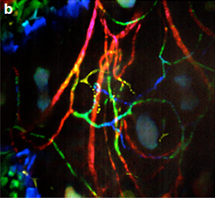Resources
 Part of the Oxford Instruments Group
Part of the Oxford Instruments Group
Expand
Collapse
 Part of the Oxford Instruments Group
Part of the Oxford Instruments Group
Cancer represents a major threat to human health, with approximately 14 million new cases being diagnosed and 7.6 million cancer deaths occurring globally every year. The use of precision medicine to accurately diagnose and treat cancer is anticipated to provide the key to preventing cancer progression.
Although technologies such as radiography, magnetic resonance imaging (MRI), positron emission tomography (PET) and computed tomography (CT) have played an extremely important role in preoperative tumor diagnosis, they have no application in intraoperative tumor surgery.
In cancer surgery, one of the main prognostic factors for patient survival is complete tumor resection and imaging modalities that allow the precise differentiation of cancerous tissue from healthy tissue, along with the identification of vital structures, would be of great benefit in helping surgeons to determine adequate tumor margins.
Over recent years, optical molecular imaging has emerged as a highly sensitive and specific method for the accurate detection of tumor margins. In particular, near-infrared fluorescence (NIRF) imaging has proved a powerful tool in helping surgeons differentiate between normal and malignant tissue in real-time.
Near-infrared fluorescence (NIRF)
NIRF imaging involves the injection of contrast agents (fluorophores) that emit light in the NIR light spectrum (650 to 900 nm), which offers distinct advantages over techniques that employ visible light. In the visible light spectrum (less than 650nm), a certain amount of photons are absorbed by hemoglobin and in the infrared region (more than 900 nm), they are largely absorbed by lipids and water.
Lying between these two regions, however, the NIR spectrum (650 to 900nm) allows for improved penetration of photons in and out of tissue because absorption, light scattering and tissue autofluorescence are relatively low, thereby offering adequate contrast. Since the human eye cannot detect wavelengths in the NIR region, the emitted light also has no effect on the surgical field.
Sentinel lymph node mapping
Currently, only two fluorophores, indocyanine green (ICG) and methylene blue (MB) have been FDA approved for use in the clinical setting. One application where these probes are currently used is a process called sentinel lymph node (SLN) mapping.
The SLN is the node that a tumor drains into directly and the site to which tumor cells are most likely to spread first. Injection of ICG or MB around a primary tumor enables identification of the SLN, which can then be resected by imaging the tracer’s drainage.
In cases where no cancerous cells are present in the SLN, it is improbable that cancer has spread to any remaining nodes, meaning their resection can be avoided and a patient’s chances of survival therefore improved.
NIRF imaging of SLN offers significant safety benefits over the use of radiotracers due to the lack of ionizing radiation and SLN mapping is therefore one of the most promising applications for NIRF imaging in the field of cancer surgery.
Detection of tumor margins in image-guided resection
Various strategies that target the visual hallmarks of cancer (e.g. increased angiogenesis, growth and proteolytic activity) are currently used in the detection of cancerous cells or tissues. A main focus of cancer research has therefore been the development of probes for use in these targeted imaging strategies.
Proteases in malignant tissue, for example, can be detected using agents that are activated by enzymes. The agents are initially nonfluorescent when injected, but become fluorescent after cleavage by a specific enzyme, which gives a high signal-to-background.
An alternative to using the detection of tumor associated proteases is the use of a monoclonal antibody coupled to a fluorophore, which can specifically detect cancer cells. Studies have shown that monoclonal antibodies coupled to fluorophores can target the Her2/neu receptor or the vascular endothelial growth factor receptor.
In addition, a key adhesion molecule in angiogenesis called alpha-v-beta (αvβ3) integrin can be targeted using cyclic arginine-glycine-aspartate coupled to one of several fluorophores.
Vital structure identification
NIRF contrast agents can be used to identify both hollow structures such as the ureter or bile duct and solid structures such as nerves. For example, ICG can be used to identify bile ducts because it is excreted into bile by the liver and MB can be used to identify both ureters and bile ducts because it is excreted by the kidney as well as the liver.
The detection of nerves still requires the development of novel fluorescent probes and this currently represents a key area of cancer research.
Detection systems
Over the last ten years, cameras referred to as electron multiplying charge coupled devices (EMCCDs) have revolutionized imaging in the field of life sciences. These instruments multiply incoming light to boost signal-to -noise ratio and have enabled researchers to access a wide range of low-light imaging applications.
The latest EMCCD camera series from Andor includes the iXon Ultra 888, which has raised the bar even further, offering frame rates that are now up to three times faster and quantitative calibration of signal in units of photons or electrons, either in real-time or post-processing.
The iXon EMCCD camera series is renowned for outstanding reliability and product quality and its track record for minimal field failures is unparalleled.

In our recent intraoperative webinar entitled "The Future Of Tumor Removal - Image Guided Intraoperative Surgery", Dr Jonathan Liu discussed how his laboratory have developed miniaturized optical-sectioning microscopes and molecularly targeted contrast agents to enable real-time point-of-care pathology for the early detection of cancers (e.g. oral cancers) as well as for guiding the surgical resection of tumors (e.g. brain tumors). In addition, he also discussed a wide-area imaging strategy to enable the quantitative molecular phenotyping of freshly excised tissues during surgery. Dr. Orla Hanrahan provided technical information relating to EMCCD and sCMOS technology and their suitability for the application of intraoperative imaging.
View our intraoperative webinar by clicking here!
Sources
